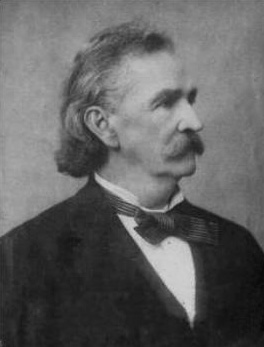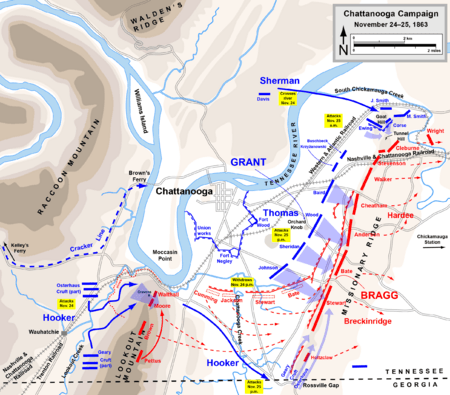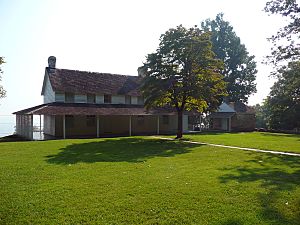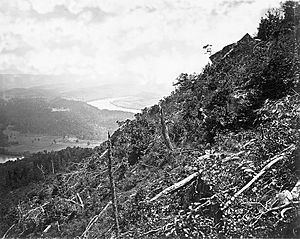Battle of Lookout Mountain facts for kids
Quick facts for kids Battle of Lookout Mountain |
|||||||
|---|---|---|---|---|---|---|---|
| Part of the American Civil War | |||||||
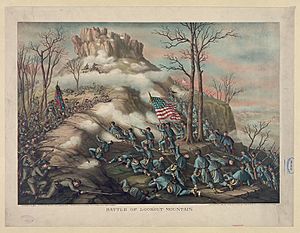 The Battle of Lookout Mountain, 1889 lithograph by Kurz and Allison |
|||||||
|
|||||||
| Belligerents | |||||||
| Commanders and leaders | |||||||
| Units involved | |||||||
|
Military Division of the Mississippi:
|
|
||||||
| Strength | |||||||
| ~12,000 | 8,726 | ||||||
| Casualties and losses | |||||||
| 671 total
(89 killed
471 wounded 111 captured/missing) |
~200 captured/killed | ||||||
The Battle of Lookout Mountain was a key fight during the American Civil War. It happened on November 24, 1863, near Chattanooga, Tennessee. Union soldiers, led by Joseph Hooker, attacked Confederate forces. These Confederate troops were defending Lookout Mountain.
This battle was part of the larger Chattanooga campaign. It helped the Union army break the Confederate hold on Chattanooga. The Union victory here also set the stage for another big battle the next day. This was the Battle of Missionary Ridge, which helped the Union win the campaign.
Contents
Why was Lookout Mountain important?
After a tough loss at the Battle of Chickamauga, the Union Army of the Cumberland had to retreat. About 40,000 soldiers went to Chattanooga. The Confederate Army of Tennessee, led by Braxton Bragg, then surrounded the city. They hoped to starve the Union troops into giving up.
Confederate soldiers took positions on Missionary Ridge and Lookout Mountain. These high spots gave them great views of Chattanooga. They could also see the Tennessee River and the Union supply routes. Lookout Mountain was a long, narrow ridge. It rose about 1,800 feet (550 meters) above the river.
Partway up the mountain was a flat area called the "bench." It was 150 to 300 feet (45 to 90 meters) wide. Above this bench, the mountain became a steep, rocky wall. Confederate cannons on the mountain controlled the river. Their cavalry also attacked Union supply wagons. This made it hard for Union soldiers to get food.
How did the Union get supplies?
The Union government was worried about their trapped army. So, they sent more soldiers. On October 17, Ulysses S. Grant took command of the Western armies. He quickly moved to help Chattanooga. He also replaced the Union commander there with George Henry Thomas.
Thomas's troops made a surprise move on October 27. They landed at Brown's Ferry. This opened up the Tennessee River. It connected Thomas's army with 20,000 new soldiers. These reinforcements were led by Joseph Hooker. Now, supplies could flow into Chattanooga. This new supply route was called the "Cracker Line."
The Confederates tried to stop this. James Longstreet attacked the Union forces in Lookout Valley. This led to the Battle of Wauhatchie on October 28–29. It was one of the few battles fought only at night. The Confederates were pushed back. The Cracker Line was safe.
Who defended Lookout Mountain?
On November 12, Carter L. Stevenson took charge of defending Lookout Mountain. His own division was at the very top. Other brigades were placed on the mountain's "bench." One Confederate general, John K. Jackson, felt it was very hard to defend this area.
Historians also noted that the mountain's strength was not as great as it looked. Union cannons from nearby Moccasin Bend could hit the bench. Also, there were many trails on the mountain's west side. These trails made it easy to reach the bench.
William Tecumseh Sherman arrived with 20,000 more Union soldiers. Grant, Sherman, and Thomas planned a big attack. They wanted to surround Bragg's Confederate army. Sherman would attack one end of Missionary Ridge. Thomas would attack the center. Hooker would capture Lookout Mountain. Then, Hooker would move to cut off the Confederate escape route.
On November 23, Grant ordered Thomas to test the Confederate lines. This was to make sure Bragg wouldn't move his troops away. Thomas sent over 14,000 men toward a small hill called Orchard Knob. They quickly took it from the Confederates.
Bragg was surprised by this. He realized his center was weak. He called back troops he had sent away. He also moved soldiers from Lookout Mountain to Missionary Ridge. This made the mountain's defense weaker.
The Union also changed their plans. One of Sherman's divisions was stuck. So, Grant decided to let Hooker attack Lookout Mountain more seriously.
Who fought at Lookout Mountain?
Union Forces
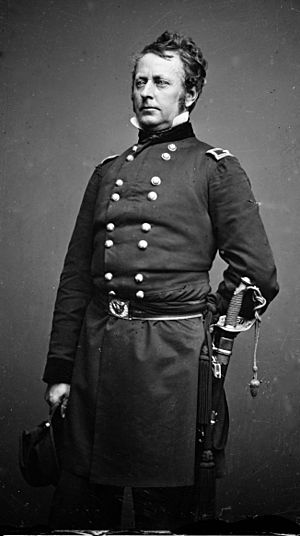
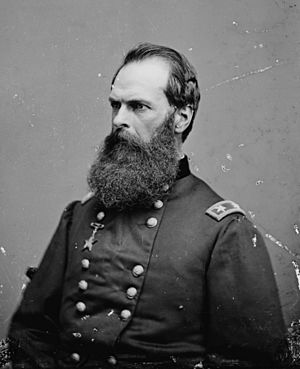
Joseph Hooker led about 10,000 Union soldiers. These soldiers came from different parts of the Union army.
- John W. Geary led a division from the XII Corps.
- Charles Cruft led a division from the IV Corps.
- Peter J. Osterhaus led a division from the XV Corps.
Confederate Forces
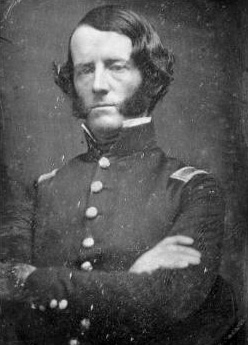
About 8,700 Confederate soldiers defended Lookout Mountain. They were led by Carter L. Stevenson. His forces included:
- Two brigades from his own division.
- Two brigades from John K. Jackson's command. These were led by Edward C. Walthall and John C. Moore.
- Two brigades from Stevenson's division. These were led by John C. Brown and Edmund Pettus.
The Battle of Lookout Mountain
On November 24, Hooker had about 10,000 men. Grant had told him to only "take the point if his demonstration should develop its practicability." But Hooker decided to launch a full attack. At 3 a.m., he ordered Geary to cross Lookout Creek. Geary was to "assault Lookout Mountain, marching down the valley and sweeping every rebel from it."
Hooker did not plan to attack the very top of the mountain. He thought that if he captured the "bench," the Confederates on top would have to leave. His soldiers would attack the bench from two sides. Union cannons were set up to help cover their advance.
Geary's crossing of Lookout Creek was delayed by high water. It finally started at 8:30 a.m. His soldiers moved through thick fog and mist. They met Confederate pickets about a mile southwest of Lookout Point. The Confederates were greatly outnumbered. They fell back, and many surrendered.
The Union soldiers kept pushing forward. Around 11:30 a.m., they met stronger Confederate resistance. Two Confederate regiments pushed back the first Union attack. But a second Union attack succeeded. The Confederates were outnumbered four to one. They had to retreat toward the Cravens house.
As Geary's men moved up, other Union brigades crossed Lookout Creek. These movements trapped some Confederate soldiers. The 34th Mississippi regiment had to surrender. About 200 men from Moore's picket line also surrendered.
The Confederate commander, Moore, was slow to react. He asked for orders, but his commander, Jackson, was far away. Jackson was criticized for not being closer to the fighting. He should have called for more soldiers.
When Stevenson heard the fighting, he sent more troops to help. Moore's soldiers fired on the Union troops. The Union soldiers pulled back behind a stone wall. Moore's 1,000 men took positions and waited. But more Union brigades arrived. Moore saw he was being surrounded. He chose to fall back to avoid being trapped.
All the Union brigades chased the retreating Confederates. Hooker was worried his lines were getting mixed up in the fog. He ordered Geary to stop. But Geary's troops were too far ahead. Hooker wrote that they were "Fired by success... they pressed impetuously forward."
Moore's brigade escaped in the fog. Walthall formed a new defensive line. His 600 men hid behind rocks and trees. They made enough noise to stop the Union advance. Then, Pettus's brigade arrived to help Walthall. For hours, the fighting continued in the dense fog. Neither side could see much or make progress.
Hooker sent mixed messages to Grant. At first, he boasted of great success and many prisoners. Later, he said his troops were out of ammunition and couldn't advance. But by sunset, Hooker was confident. He told Grant he would move into Chattanooga Valley once the fog lifted. He believed the Confederates would leave that night.
Bragg sent reinforcements to Stevenson. But he ordered Stevenson to pull back to the east side of Chattanooga Creek. Stevenson wanted to wait until his troops on the summit could escape. Walthall, Pettus, and Moore were ordered to hold their positions. They fought for hours in the fog.
What happened next?
By midnight, Lookout Mountain was quiet. Pettus and Holtzclaw received orders to leave the mountain at 2 a.m. Veterans later wrote about a bright moon that turned black. This was a total lunar eclipse, which helped hide the Confederate retreat.
That night, Bragg was shocked by the loss of Lookout Mountain. He asked his commanders if they should retreat or keep fighting. One commander, Hardee, advised retreating. But Breckinridge convinced Bragg to stay and fight on Missionary Ridge. So, the troops from Lookout Mountain were moved to Missionary Ridge.
On November 25, Hooker's men had trouble rebuilding bridges. This delayed their move to Missionary Ridge. They reached the Rossville Gap as Thomas's men were attacking Missionary Ridge. Hooker turned his divisions north. He attacked Bragg's side, further breaking the Confederate line. This sent the Confederate Army of Tennessee into a full retreat.
The Battle of Lookout Mountain had relatively few casualties. About 671 Union soldiers were lost. The Confederates lost about 1,251, including many captured. One reporter called it more like a "magnificent skirmish" than a major battle.
General Grant later downplayed Hooker's success. He wrote that "There was no such battle and no action even worthy to be called the battle on Lookout Mountain. It is all poetry." However, this battle was very important. It helped the Union control the Tennessee River and the railroad. It also put the entire Confederate line on Missionary Ridge in danger.
An army general, Montgomery C. Meigs, watched the battle from Orchard Knob. He was the first to call it the "Battle Above the Clouds."
Portions of the Lookout Mountain battlefield are now part of the Chickamauga and Chattanooga National Military Park. This park helps preserve the history of these important events.
Images for kids


